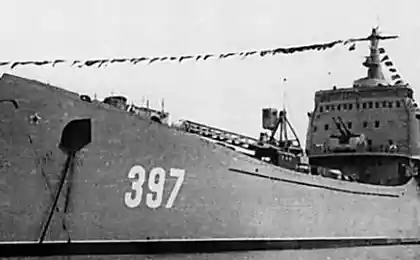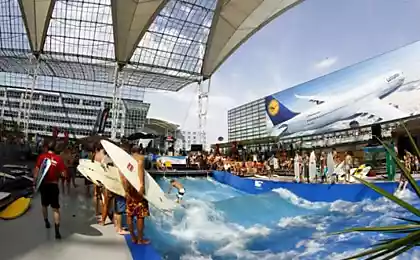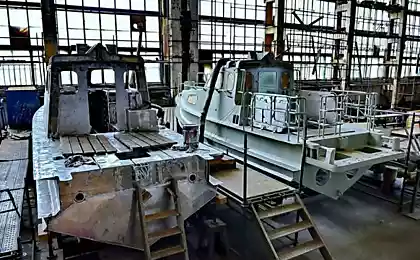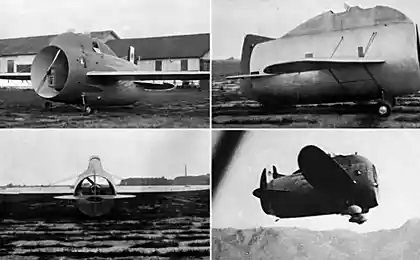1562
Hovercrafts

The gist of it was this.
If powerful fan flat bilge pump air, the water resistance will decrease; hence increase speed. And that air is not "run away" in hand, need to equip the hull longitudinal keels - skeg.
The first to realize this idea failed Austrian engineer Dagoberto Mueller von Tomamyulyu in 1916. He created the torpedo boat was able to develop a speed of almost 40 knots - 74, 08 kilometers per hour, the engine power is 480 horsepower sil.Zatem a new idea: skegs replaced rubber "skirt". Now the air is pumped out from the bottom of even slower, and gets a real theft. Vessels of this type is really hovering over the water, can "crawl" on the beach and even travel by land.
The first idea of such a machine hovercraft expressed KE Tsiolkovsky in 1927, in the "air resistance and a fast train." It is wheel-less layer of compressed air.
This idea prompted the Novocherkassk Polytechnic Institute assistant professor Vladimir Levkova to create their own design, though not train and boat.
And here is what the magazine "World Pathfinder" Stanislav Zigunenko, "he began, as usual, with settlements and the construction of models. The first construction built young scientists-aerodynamics, an inverted basin. Lightweight wooden frame stretched across tracing paper, and where a conventional basin is believed to be the bottom of the standing electric motor with a propeller. Screw, pumping the air, under the "basin" was pressurized. And the whole structure as it floated above the floor, leaning on a cushion of air.
About five years experienced Levkov this simple model, trying to understand how it can be controlled, how high must be created by theft, and to not waste excess power and the future of the ship progressed as much as possible speed ...
In 1932, Levko already professor, began testing the new model. It had an elongated teardrop shape, with two engines: in the bow and stern. Small hovercraft glide easily over the tiled floors aerodynamic laboratory
Soon the view of the model changed again. She became like a long inverted box with cut angled sides. The cutout in an inclined position were strengthened electric motors with propellers. The rejected screw air accumulates under the body model, she lifted her. Under this scheme, then we create all Levkova first big hovercraft ».
Levkov the spring of 1934 he moved to Moscow - he was invited to work at the Moscow Aviation Institute (MAI). He brought with him a large (more than two meters long) model hovercraft. Designed according to the rules of structural mechanics, it makes a good impression. Conspicuous ease of design and beautiful exterior design of the model. Mass it was only about six kilograms.
To test the model in the MAI took a special room. It staged a shallow pool. Above him stretched the two wires to power the electric motors of small boats. He flew it well. For a couple of seconds, easy to carry from one side of the pool to the other.
Then it was organized Experimental Design Bureau headed by Professor Levkova. It has begun to develop three-boat "L-1". Test it began the summer of 1935 near Moscow, Lake Pleshcheyevo.
Weight boats were 1, 5 tons. Its wooden body consisted of two narrow boats, connected platform. Two aircraft engine with screws pumped air into the space bounded by the platform and boats. Managed boat using butterfly valves - shutters, reinforced by motors. When upright damper air flow is directed downward, and the boat hung motionless. If shutters deflected back reaction force was moving the boat forward, deflected forward - back up. In addition, there was a vertical and horizontal tail, which also participated in the management of a flying boat.
This boat has become the prototype of other flying courts established under the leadership of Levkova, in particular boats "A-5" Weight it reached 9 tonnes because its hull was already metal, duralumin. Behind the cab driver and mechanic made a space for passengers.
First, the boat was tested on land. Viewed as it flies. Then began sea trials. The car tried to accompany conventional boats, but soon they were hopelessly behind. And when the stopwatch measured mile, the testers did not believe my eyes: it turned out that the speed of the boat - more than seventy knots, or about 140 kilometers per hour! The tests also showed that the boat could be as free to pass over the marsh, over the snow-covered field or ice
The test results were very interested in the military, and Professor Levkov soon headed the Special Design Bureau hovercraft. Build ships weighing up to 15 tons. To design even more - up to 30 tons with two engines.
Since more than sixty years ago, the Soviet Union built a small fleet of a dozen hovercraft. Unfortunately, during World War II pilot boat in the Baltic Sea, were killed. After the victory of the development of such vessels were continued. But in early 1954, Professor Levkov died and the case has stalled.
An important stage in the development of hovercraft was the invention in England in 1955, Professor Christopher Kokkerellom nozzle forming circuit of the air cushion. He also belongs to the invention of flexible fencing that were immediately appreciated in our country.
In 1959, the English Channel had a strange ship with a cylindrical tower in the middle. Starting from France, it crossed the strait. Reaching the coast it is, as if nothing had happened, continued on his way. The vessel, designed Cockerell, conceded Levkovsky doubled in weight and three times the speed.
Now hovercraft is not unusual. Improvement of their work in many countries. They found a very promising form of transportation. They are used as a landing craft in the Navy as a civilian ferries that move these people and vehicles through the same Channel.
One of the most successful foreign developments - established in the UK in 1972, 33-ton boat BH-7 "Wellington." It can carry 14 tons of cargo and while flying over the water at a speed of 60 knots - 111, 12 kilometers per hour
In the USSR the first to appreciate the enormous possibilities of amphibious ships Navy specialists After the break, continue the work initiated Levkova, but at a new level of funding base was established for the design and production of landing craft
Leading enterprises of Russia in the field of hovercraft is the Central Marine Design Bureau "Almaz»
The first production under construction was the landing craft "Scat" He could be transported at a speed of forty Marines 49 knots on their basis were created three boats to rescue the astronauts
It was followed by "Squid", with a displacement of 114 tons He could carry loads of up to 37 tonnes at speeds up to 55 knots
A total of "Diamond" series vessels were built on ten projects. Among them is the landing craft "Zubr", load capacity of 150 tons, and the total displacement - 550 tons, full speed - 60 knots and 40 - with waves height of 2 meters Experts believe that a displacement of 1,000 tons is not the limit for the displacement of these ships and in practice can be achieved speeds of up to 80 knots
In 1987, the Soviet Union was created by a small rocket ship "Bora" - the world's largest hovercraft him transcend even vosmibalny storm, and if the sea is calm, it is moving at a speed of 53 knots - 98, 16 kilometers per hour
"Diamond" has developed a number of projects hovercraft civil River cargo ship "Beaver" passenger hovercraft Project 12270 multipurpose hovercraft "Chilim»
Depending on the destination of ships changing such an important parameter as the installed power per ton of displacement boats for military purposes, where economic indicators have not operation prevailing values, the figure is in the range of 65 to 120 kW per tonne Such high power is not caused by the size of the full running speed in calm water and at low agitation to achieve it using only 60-70 percent of the installed capacity is another reason - the need to achieve a given rate guaranteed rough seas in the practice of civilian shipbuilding, where the rate determines the efficiency of operation, in spite of the possible failures of flights due to weather conditions it can be brought up to 30-36 kW per tonne while maintaining the speed of 40-50 knots in calm water
The first hovercraft, following the aviation traditions created riveted, but the experience of their operation in the sea showed low reliability of this type of connection Since 1974, housing steel welded They were created by high-strength corrosion resistant marine aluminum-magnesium alloys, and started production of pressed panels with ribs various sections
A large amount of research has been conducted in the development of flexible barriers were installed according to the strength and durability of the materials of flexible fencing on the nature of applicable filaments, twisting and type of weave filaments yarns, impregnation and the composition of the coating rubber mixtures are used on ships recent projects rubberized materials provide good seaworthiness of vessels and the possibility of long-term operation without repair
For the hovercraft had developed and a special profile propeller blades, which allowed to achieve high efficiency at low, compared to the aircraft, speed for all hovercraft displacement of more than 100 tons have developed a single propeller hub, providing high uptime air screws when changing their pitch
Defines values for seaworthiness, amphibious and durability of the flexible enclosure has a flow rate of air through the air cushion to air our scientists have developed a special scheme of axial and centrifugal compressors, which have high efficiency at small dimensions
For driving screws, compressors and other users have been created gazoturbozubchatye high-assemblies on their weight and size and operating parameters of these units to date occupy a leading place in the world
Secure high-speed vessel is largely determined by the availability of reliable and proven traffic management systems peculiarity hovercraft is the lack of direct contact between the steering device with water, making it difficult to maneuver and makes the boat very dependent on the weather in Russia developed and tested various schemes of ship management, including aerodynamic steering wheels, steering wheels, jet (jet nozzle), variable pitch screws























